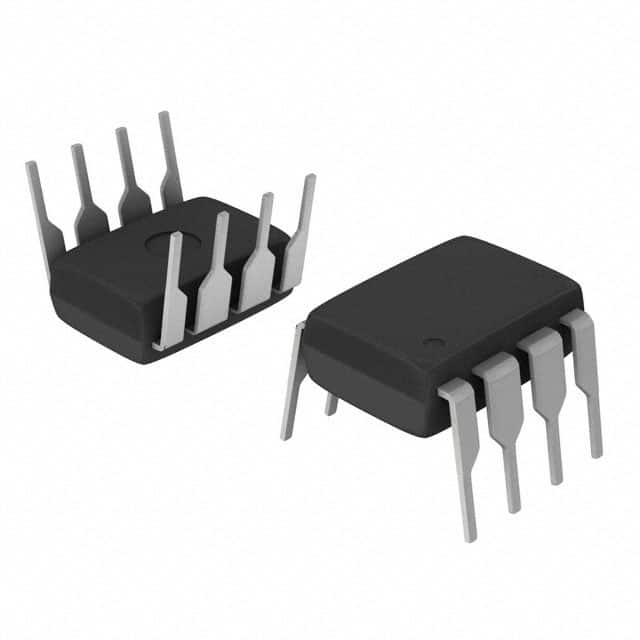Consulte las especificaciones para obtener detalles del producto.

MCP4151-503E/P
Product Overview
Category
The MCP4151-503E/P belongs to the category of digital potentiometers.
Use
It is commonly used in electronic circuits for controlling resistance values digitally.
Characteristics
- Digital control of resistance
- Compact package size
- Low power consumption
- High resolution
- Non-volatile memory
Package
The MCP4151-503E/P is available in a small 8-pin PDIP (Plastic Dual Inline Package) format.
Essence
The essence of the MCP4151-503E/P lies in its ability to provide precise and programmable resistance values in electronic circuits.
Packaging/Quantity
This product is typically packaged in reels or tubes, with a quantity of 250 units per reel/tube.
Specifications
- Resistance Range: 0Ω to 50kΩ
- Resolution: 256 steps
- Supply Voltage: 2.7V to 5.5V
- Temperature Range: -40°C to +125°C
- Interface: SPI (Serial Peripheral Interface)
- Non-Volatile Memory: Yes
Detailed Pin Configuration
The MCP4151-503E/P has the following pin configuration:
- VDD - Power supply voltage input
- CS - Chip select input for SPI communication
- SCK - Serial clock input for SPI communication
- SI - Serial data input for SPI communication
- SO - Serial data output for SPI communication
- WP - Write protect input for non-volatile memory
- H/L - Terminal A of the potentiometer
- W - Wiper terminal of the potentiometer
Functional Features
- Digital control of resistance allows for precise adjustment in electronic circuits.
- SPI interface enables easy integration with microcontrollers and other digital devices.
- Non-volatile memory ensures that the resistance value is retained even when power is disconnected.
- High resolution of 256 steps allows for fine-grained adjustment.
Advantages and Disadvantages
Advantages
- Precise and programmable resistance control
- Compact package size for space-constrained applications
- Low power consumption
- Non-volatile memory for retaining resistance values
- High resolution for fine adjustment
Disadvantages
- Limited resistance range (0Ω to 50kΩ)
- Requires SPI interface for communication
Working Principles
The MCP4151-503E/P operates by digitally controlling the resistance between its terminal A and wiper terminal. This is achieved through the use of a digital-to-analog converter (DAC) and a resistor network. The resistance value is adjusted by sending commands via the SPI interface, which controls the position of the wiper within the resistor network.
Detailed Application Field Plans
The MCP4151-503E/P finds application in various fields, including:
- Audio Equipment: Used for volume control and tone adjustment in amplifiers, mixers, and audio processors.
- Industrial Automation: Employed in control systems for precise resistance adjustment in sensors, actuators, and motor control circuits.
- Test and Measurement Instruments: Integrated into equipment for calibration and signal conditioning purposes.
- Consumer Electronics: Utilized in devices such as televisions, set-top boxes, and gaming consoles for user-controlled settings.
Detailed and Complete Alternative Models
Some alternative models to the MCP4151-503E/P include:
- MCP4131-103E/P: Similar specifications but with a lower resistance range (0Ω to 10kΩ).
- MCP4161-104E/P: Higher resistance range (0Ω to 100kΩ) with the same resolution and features.
- MCP4251-502E/P: Dual-channel digital potentiometer with two independent potentiometers in a single package.
These alternative models provide options for different resistance ranges and additional features based on specific application requirements.
Word count: 543 words
Enumere 10 preguntas y respuestas comunes relacionadas con la aplicación de MCP4151-503E/P en soluciones técnicas
What is the MCP4151-503E/P?
The MCP4151-503E/P is a digital potentiometer, also known as a digital variable resistor, that can be used to digitally control resistance in electronic circuits.What is the typical application of MCP4151-503E/P?
The MCP4151-503E/P is commonly used in applications where precise and digitally controlled resistance adjustments are required, such as in audio equipment, instrumentation, and industrial control systems.What is the maximum resistance value of MCP4151-503E/P?
The MCP4151-503E/P has a maximum resistance value of 50 kΩ.Can the MCP4151-503E/P be used in low-power applications?
Yes, the MCP4151-503E/P is designed for low-power applications, making it suitable for battery-powered devices and other energy-efficient solutions.Is the MCP4151-503E/P compatible with microcontrollers?
Yes, the MCP4151-503E/P can be easily interfaced with microcontrollers through its digital interface, allowing for seamless integration into digital control systems.What is the resolution of the MCP4151-503E/P?
The MCP4151-503E/P has a resolution of 256 steps, providing fine-grained control over resistance adjustments.Can the MCP4151-503E/P be used in harsh environments?
The MCP4151-503E/P is designed to withstand harsh environmental conditions, including wide temperature ranges and high humidity levels, making it suitable for rugged applications.What is the supply voltage range of the MCP4151-503E/P?
The MCP4151-503E/P operates within a supply voltage range of 2.7V to 5.5V, making it compatible with a wide range of power sources.Does the MCP4151-503E/P support non-volatile memory?
Yes, the MCP4151-503E/P features non-volatile memory, allowing it to retain its settings even when power is removed.Can multiple MCP4151-503E/P devices be daisy-chained together?
Yes, multiple MCP4151-503E/P devices can be daisy-chained together to provide simultaneous control of multiple channels or to expand the number of available resistance steps.

